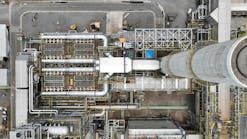CVR Energy lets contract for Wynnewood refinery renewables project
CVR Energy Inc. has let a contract to Haldor Topsoe AS to provide process technology for the operator’s previously announced renewable diesel production project at subsidiary Wynnewood Refining Co. LLC’s (WRC) 74,500-b/d refinery in Wynnewood, Okla. (OGJ, Dec. 7, 2020, p. 18; OGJ, Oct. 5, 2020, p. 38).
As part of the contract, Haldor Topsoe will license its proprietary HydroFlex renewable fuel technology as well as supply basic engineering, proprietary equipment, and catalysts for the revamp of an existing hydrocracker at the refinery to enable production of about 100 million gal/year of low-carbon renewable diesel from soybean oil, the service provider said on Jan. 27.
Already under way and scheduled to be completed in July 2021, the $110-million project will allow WRC to produce renewable diesel that meets the ASTM D975 diesel specification and qualify for programs such as the California help reduce greenhouse gas (GHG) emissions from the site, as well as allow WRC to qualify for low-carbon fuel standard (LCFS) programs such as the California LCFS, according to Haldor Topsoe.
Details regarding the specific value of the contract were not disclosed.
Project background
The contract award follows CVR Energy’s late-2020 confirmation that its board of directors fully approved WRC’s renewable diesel project, which will convert a 19,000-b/d hydrocracker at the refinery to allow processing of a 100-million gal/year primary feedstock of readily available, extremely low-carbon intensity (CI) refined and bleached soybean oil from Washington into renewable diesel as well as 6 million gal/year of renewable naphtha.
By yearend 2020, WRC had undertaken detailed engineering design work, ordered long lead-time equipment, and started construction on the project as authorized by the Oklahoma Department of Environmental Quality’s permitting rules, CVR Energy said in a Dec. 21, 2020, release.
Including tanks, a rail terminal, and a staging facility, CVR Energy’s total $110-million cost of the WRC project—which is designed to take advantage of the Wynnewood refinery’s excess hydrogen capacity and reduce its annual Renewable Identification Number (RIN) exposure under the US Clean Air Act’s Renewable Fuel Standard (RFS)—should be recouped by yearend 2022 via generation of RINs as well as biodiesel mixture excise and biodiesel production and blending tax credits, according to David Lamp, CVR Energy’s chief executive officer.
“Between our existing blending capabilities and the RINs generated from renewable diesel, we expect our total net purchases would be less than 80 million RINs/year once [WRC’s converted hydrocracking] unit is up and running,” Lamp said.
CVR Energy anticipates renewable diesel and naphtha production from WRC’s revamped hydrocracker to generate 170-180 million RINs.
Once in operation, the Wynnewood hydrocracker renewable conversion project will reduce WRC’s overall crude throughputs to between 55,000-59,000 b/d, Lamp said on a Nov. 3, 2020, call with investors.
Renewable diesel strategy
Part of Phase 1 of CVR Energy’s broader renewable diesel strategy, the WRC hydrocracker conversion—which will retain the unit’s flexibility to return to conventional hydrocarbon processing should economics support doing so—could be followed by future phases involving installation of a pretreatment unit (PTU) at the refinery for processing of inedible corn oil, animal fats, and used cooking oil (UCO), as well as related projects at subsidiary Coffeyville Resources Refining & Marketing LLC’s 132,000-b/d refinery in Coffeyville, Kan.
In a January presentation to investors, CVR Energy said existing excess hydrogen and high-pressure hydrotreating capacities at Coffeyville may enable a similar—and potentially larger—renewables conversion project at that site.

Robert Brelsford | Downstream Editor
Robert Brelsford joined Oil & Gas Journal in October 2013 as downstream technology editor after 8 years as a crude oil price and news reporter on spot crude transactions at the US Gulf Coast, West Coast, Canadian, and Latin American markets. He holds a BA (2000) in English from Rice University and an MS (2003) in education and social policy from Northwestern University.
